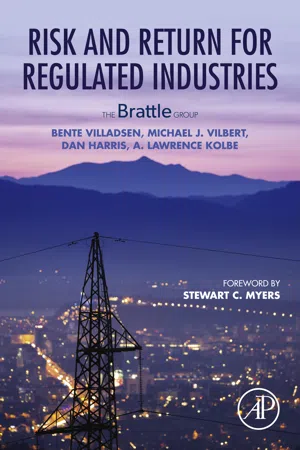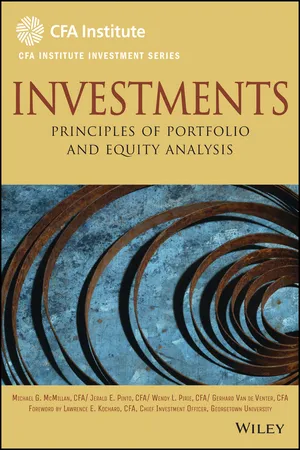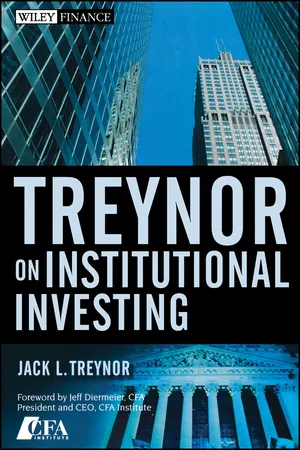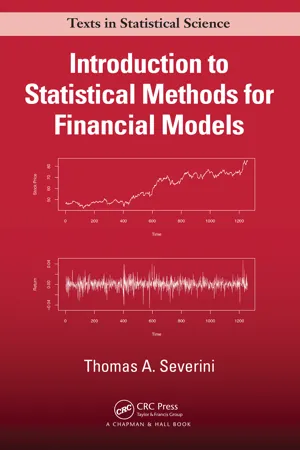Capital Asset Pricing Model
The Capital Asset Pricing Model (CAPM) is a financial model used to determine the expected return on an investment based on its risk. It takes into account the risk-free rate of return, the market risk premium, and the asset's beta, which measures its volatility in relation to the overall market. CAPM is widely used in finance to evaluate the potential return of an investment relative to its risk.
8 Key excerpts on "Capital Asset Pricing Model"
- eBook - ePub
Business
The Ultimate Resource
- Bloomsbury Publishing(Author)
- 2011(Publication Date)
...Calculating a Capital Asset Pricing Model WHAT IT MEASURES The relationship between the risk and expected return of a security or stock portfolio. WHY IT IS IMPORTANT The Capital Asset Pricing Model’s (CAPM) importance is twofold. First, it serves as a model for pricing the risk in all securities, and thus helps investors evaluate and measure portfolio risk and the returns they can anticipate for taking such risks. Secondly, the theory behind the formula also has fueled—some might say provoked—spirited debate among economists about the nature of investment risk itself. The CAPM model attempts to describe how the market values investments with expected returns. The CAPM theory classifies risk as being either diversifiable, which can be avoided by sound investing, or systematic, that is, not diversified and unavoidable due to the nature of the market itself. The theory contends that investors are rewarded only for assuming systematic risk, because they can mitigate diversifiable risk by building a portfolio of both risky stocks and sound ones. One analysis has characterized the CAPM as “a theory of equilibrium” that links higher expected returns in strong markets with the greater risk of suffering heavy losses in weak markets. Otherwise, no one would invest in high-risk stocks. HOW IT WORKS IN PRACTICE CAPM holds that the expected return of a security or a portfolio equals the rate on a risk-free security plus a risk premium. If this expected return does not meet or beat a theoretical required return, the investment should not be undertaken. The formula used to create CAPM is: risk-free rate + (market return – risk-free rate) x beta value = expected return The risk-free rate is the quoted rate on an asset that has virtually no risk. In practice, it is the rate quoted for 90-day US Treasury bills. The market return is the percentage return expected of the overall market, typically a published index such as Standard & Poor’s...
- eBook - ePub
- Bente Villadsen, Michael J. Vilbert, Dan Harris, Lawrence Kolbe(Authors)
- 2017(Publication Date)
- Academic Press(Publisher)
...Chapter 4 The Capital Asset Pricing Model and Variations Abstract The Capital Asset Pricing Model (CAPM) estimates the cost of capital as the sum of a risk-free rate and a premium for the risk of the particular security. In the theoretical version of the CAPM, the best proxy for the risk-free rate is the short-term government interest rate. The risk premium is the product of the premium required on an average-risk investment (called the “market risk premium” or MRP) and the relative risk of the security in question (called beta). The MRP cannot be directly observed nor can a security's true beta. Even the measure of the risk-free rate is subject to debate. The chapter also addresses the problem that empirical tests of the CAPM show that while a stock's risk premium is indeed directly proportional to its beta as predicted by the CAPM, the slope of the proportionality is not as “steep” as the CAPM predicts. Low-beta stocks appear to have higher costs of capital and high-beta stocks lower costs of capital than predicted by the CAPM. Keywords Business risk; Capital Asset Pricing Model (CAPM); Debt-to-equity ratio; Diversifiable risk; Diversification; Financial risk; Gearing; Leverage; Market proxy; Market risk premium; Security market line; Systematic risk; Wright method Introduction This chapter reviews the principles behind the first formal model of how the cost of capital is determined, the Capital Asset Pricing Model (CAPM). It describes the estimation of the parameters used in the model, reviews the strengths and weaknesses of the model, and reviews the results of the empirical tests. While probably the most widely used cost of capital estimation method in the world, the CAPM generally has not been confirmed by empirical tests, which has given rise to issues discussed at the end of the chapter. Because a great deal of the financial literature of the last half-century has addressed issues relevant to the CAPM, this chapter is far longer than others...
- eBook - ePub
Investments
Principles of Portfolio and Equity Analysis
- Michael McMillan, Jerald E. Pinto, Wendy L. Pirie, Gerhard Van de Venter(Authors)
- 2011(Publication Date)
- Wiley(Publisher)
...stocks. Note the emphasis on U.S. stocks; because these factors were estimated for U.S. stocks, they have worked well for U.S. stocks over the past several years. Three observations are in order. First, no strong economic arguments exist for the three additional risk factors. Second, the four-factor model does not necessarily apply to other assets or assets in other countries, and third, there is no expectation that the model will continue to work well in the future. 5.4. The CAPM and Beyond The CAPM has limitations and, more importantly, is ineffective in modeling asset returns. However, it is a simple model that allows us to estimate returns and evaluate performance. The newer models provide alternatives to the CAPM, although they are not necessarily better in all situations or practical in their application in the real world. 6. SUMMARY In this chapter, we discussed the Capital Asset Pricing Model in detail and covered related topics such as the capital market line. The chapter began with an interpretation of the CML, uses of the market portfolio as a passive management strategy, and leveraging of the market portfolio to obtain a higher expected return. Next, we discussed systematic and nonsystematic risk and why one should not expect to be compensated for taking on nonsystematic risk. The discussion of systematic and nonsystematic risk was followed by an introduction to beta and return-generating models. This broad topic was then broken down into a discussion of the CAPM and, more specifically, the relationship between beta and expected return. The final section included applications of the CAPM to capital budgeting, portfolio performance evaluation, and security selection...
- eBook - ePub
- Jack L. Treynor(Author)
- 2011(Publication Date)
- Wiley(Publisher)
...PART Two CAPM Many investors are uncomfortable with bearing risk. The Capital Asset Pricing Model (CAPM) addresses the question: How will that discomfort be reflected in the way a rational market chooses its discount rates? Which risks will require an extra element of expected return? How much? If they aren’t correlated with other risks, many investment risks that loom large for an individual company, or even for an industry, will have little impact on the market portfolio. But some risks affect so many stocks—so many industries—that they contribute significant risk to the market portfolio. A rational stock market will reward investors for bearing these so-called systematic risks. William Sharpe’s 1963 paper on the Diagonal Model contained a single risk factor to which all stocks were sensitive, albeit in varying degrees, as well as an additional source of risk specific to each stock. Because the latter diversified and the former didn’t, the former explained market fluctuations. In using a single factor to explain the distinction between systematic risk and specific risk, Sharpe’s paper introduced what came to be called the Market Model. However, as he would be the first to point out, more than one macro variable can have enough impact to affect the overall market. The CAPM makes no assumptions about the number of systematic factors. Instead, the CAPM argues that different factors will carry different risk premiums, depending on their impact on the value of the market portfolio. J.L.T. CHAPTER 6 Toward a Theory of Market Value of Risky Assets a The objective of this study is to lay the groundwork for a theory of market value that incorporates risk. We consider a highly idealized model of a capital market in which it is relatively easy to see how risk premiums implicit in present share prices are related to the portfolio decisions of individual investors...
- eBook - ePub
The Capital Budgeting Decision
Economic Analysis of Investment Projects
- Harold Bierman, Jr., Seymour Smidt(Authors)
- 2012(Publication Date)
- Routledge(Publisher)
...The model needs expectations in order to be used correctly. All we have are data based on past events that we may use to estimate the variables that we need. For example, one problem is that the beta will change through time. Also, the value of r f will depend on the maturity of the government security that is used. It is not easy to use the CAPM in an exact manner. One important use of CAPM is in estimating the required expected rate of return for an asset. Required Rate of Return Versus WACC In capital budgeting practice, a commonly used criterion for making accept or reject decisions is to compare the internal rate of return for an investment with the firm’s weighted average cost of capital (WACC). The WACC represents the required rate of return for the firm as a whole and, as its name suggests, is an average. Those who advocate this procedure recommend accepting the investment if its expected internal rate of return exceeds or is equal to the firm’s cost of capital. Figure 8.10 shows both the WACC (WACC = 0.15) and the security market line. The two lines imply different investment criteria; in each case the line is the boundary between the accept region (above the line) and the reject region (below the line). For investments D and G both criteria lead to the same decision. For investments C, E, and F, contradictory recommendations would result. Investments F and E would be rejected by the WACC criterion – but they would be acceptable using the Capital Asset Pricing Model approach, even though E yields less than the default-free return. Investment C would be accepted using the WACC of 0.15, but it would be rejected using the CAPM approach. Figure 8.10 A firm with a weighted average cost of capital (WACC) of 0.15 Figure 8.10 illustrates one important limitation of the WACC approach: the fact that it does not take into account variations in the riskiness of different projects...
- eBook - ePub
- Alan J. Baker(Author)
- 2018(Publication Date)
- Routledge(Publisher)
...(Numerous studies illustrate the dramatic reduction in diversiflable risk that can be achieved through the random selection of a fairly small number of securities; see Sharpe, 1978, pp. 113-17.) This helps us to understand why, in equation (xvi), the risk premium for security i depends only on its undiversifiable risk, as measured by β i. Capital market theory holds that the market offers no premium for risks that the individual investor is perfectly capable of neutralising by his own actions in diversifying his portfolio (recall that we are still assuming that all transactions are costless). 10.2 (vi) Qualifications to the Capital Asset Pricing Model Before we consider the strong implications of the CAPM for capital budgeting by firms, we should be aware of the aspects of the model that may cause us to question its practical relevance. The assumptions in this category are: (1) all investors hold the same expectations about all securities and all correlation coefficients, with information about securities’ prospects being made available simultaneously and at zero cost to all investors; (2) all investors can lend or borrow freely at the same risk-free interest rate; (3) there are no transactions costs; (4) the absence of distorting effects of taxation, whether between dividend income and capital gains or between different groups of investors; (5) all investors are similarly motivated in the general nature of their utility functions and the one-period horizon they all observe in their portfolio decision making. We cannot enter here into the considerable literature devoted to the measurement of capital market efficiency in the sense implied by these assumptions and to establishing the robustness of the CAPM under various types of departure from the ideal. (For a summary of various empirical tests of the CAPM, see Firth, 1977, pp...
- eBook - ePub
- Frank J. Fabozzi, Frank J. Fabozzi(Authors)
- 2012(Publication Date)
- Wiley(Publisher)
...Capital Asset Pricing Models FRANK J. FABOZZI, PhD, CFA, CPA Professor of Finance, EDHEC Business School HARRY M. MARKOWITZ, PhD Consultant Abstract: Risk-return analysis in finance is a “normative” theory: It does not purport to describe, rather it offers advice. Specifically, it offers advice to an investor regarding how to manage a portfolio of securities. The investor may be an institution, such as a pension fund or endowment; or it may be an asset management firm with multiple portfolios to manage (e.g., managing various mutual funds and funds for institutional clients). The focus of risk-return analysis is on advice for each individual portfolio. This contrasts with Capital Asset Pricing Models, which are hypotheses concerning capital markets as a whole. They are “positive” models, that is, they are hypotheses about that which is—as opposed to “normative” models, which advise on what should be or, more precisely, advise on what an investor should do. INTRODUCTION Asset pricing theory seeks to explain how the price or value of a claim from ownership of a financial asset is determined. The pricing or valuation of an asset must take into account the timing of the payments expected to be received and the risk associated with receiving the expected payments. The major challenge in asset pricing theory is often not the timing issue but the treatment of risk. The formulation of an asset pricing theory that has empirically proven to have good predictive value offers investors the opportunity to capitalize on mispriced assets. Moreover, the theory provides investors with a tool for pricing new financial instruments and nonpublicly traded assets. Cochrane (2001) suggests two popular approaches to asset pricing: absolute pricing and relative pricing. The absolute pricing approach seeks to price an asset by reference to its exposure to fundamental macroeconomic risk...
- Thomas A Severini(Author)
- 2017(Publication Date)
- Chapman and Hall/CRC(Publisher)
...However, there are a number of different implications of this result and, in this section, we consider several of these. The CAPM, as given in Proposition 7.1, describes a relationship between the expected return on a portfolio and the expected return on a market portfolio in terms of the standard deviations of the returns and their correlation. However, that result also implies a relationship for the returns themselves. Corollary 7.1. Let R i denote the return on an asset, let R m denote the return on the market portfolio, let R f denote the return on the risk-free asset, and let β i = Cov (R i, R m) ∕ Var (R m). Then we may write R i − R f = β i (R m − R f) + Z i for a random variable Z i that has mean 0 and that is uncorrelated with R m. Proof. Note that Z i may be written Z i = R i − R f − β i (R m − R f), (7.12) where β i is as given in the statement of the corollary. Then, according to Proposition 7.1, Z i has expected value 0: E (Z i) = μ i − μ f − β i (μ m − μ f) = 0. Furthermore, using properties of. covariance, Cov (Z i, R m) = Cov (R i − μ f − β i (R m − μ f), R m) = Cov (R i, R m) − β i Var (R m) = 0 so that Z i is uncorrelated with the market return. It is important to note that it is always true. that R i − μ f = β i (R m − μ f) + Z i where Z i and R m are uncorrelated; the fact that β i = Cov (R i, R m) ∕ Var (R m) implies that Cov (Z i, R m) = 0. The role of the CAPM is to show that E (Z i) = 0. Example 7.2 As in Example 7.1, suppose that the return on the market portfolio has an expected value μ m = 0. 0 2 5 and a standard deviation σ m = 0. 0 4 and suppose that the risk-free rate of return is μ f = 0. 0 0 5. Consider an asset with a return with a mean and standard deviation of μ i = 0. 0 2 and σ i = 0. 0 5, respectively, and suppose that β i = 0. 7 5. Let R i and R m denote the returns on the asset and the market portfolio, respectively...







